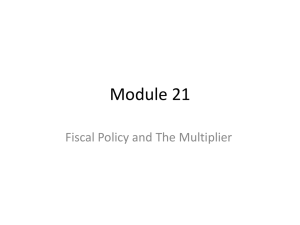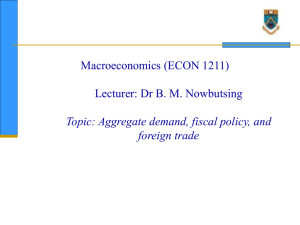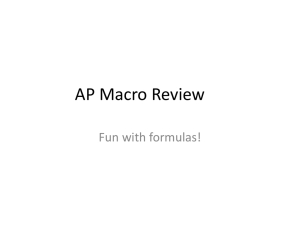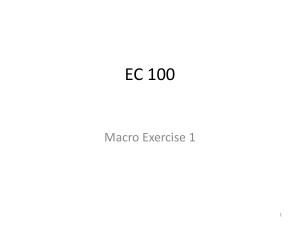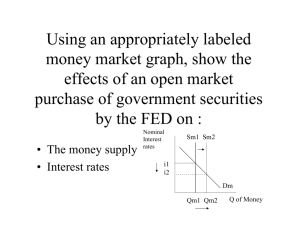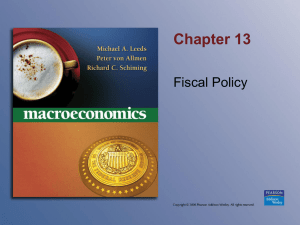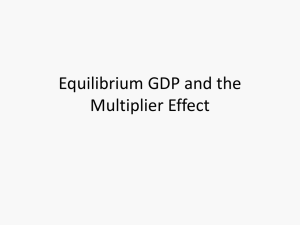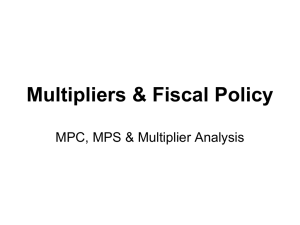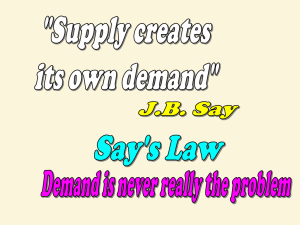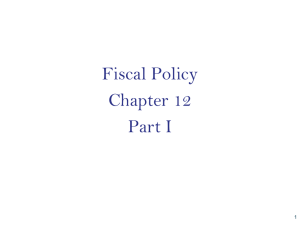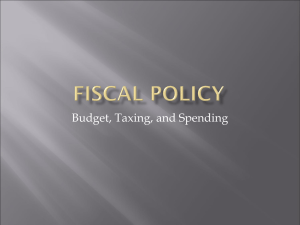Macro11
advertisement
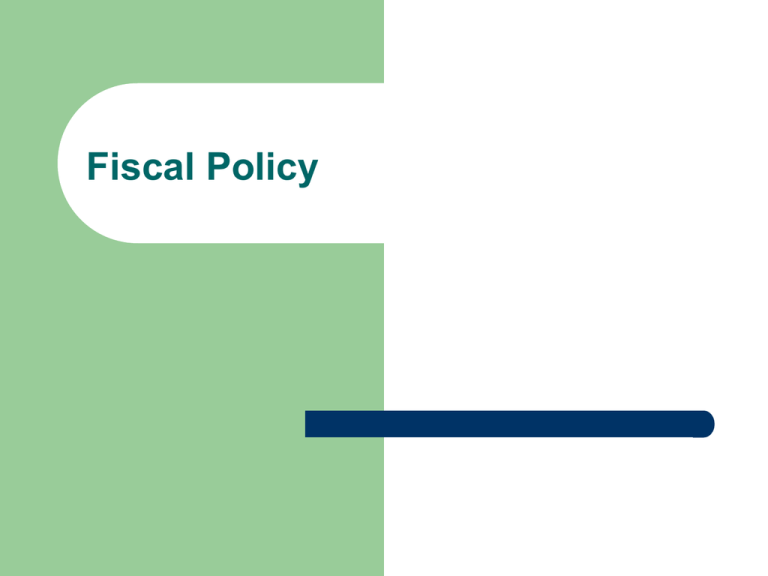
Fiscal Policy Government spending, tax, and budget balance Government Spending: G Government Revenue: Tax Government spending, tax, and budget balance Deficit =G-T Two fiscal components in AE: G and T AE = C + I + G + X - IM = a + b (Y - T ) + I + G + X - IM Tax Lump-sum Tax – is a fixed amount tax, regardless of the GDP level. Income Tax – Depends on the income level Lump-sum Tax and its effect on AE A parallel shift in the AE line Consumption function in the Y-C Space C’ C C Changes in T C = ( a – bT) + b Y a – bT 0 Y (GDP) AE in the AE-Y space AE AE = C + I + G + X - IM cut in T 0 Y Example of a Model economy C = 360 + 0.8 DI I = 300 G = 200 X - IM = 0 T = 200 Assume that the potential GDP is 4000 Example of a Model economy Assume prices are fixed, what is the equilibrium level of Y? AE =360+0.8(Y-200)+300+200+0 = 0.8 Y + 700 Y = AE = 0.8 Y + 700 (1-0.8) Y = 700 Y* = 1/(1-0.8) X 700 = 5 X 700 = 3500 Example of a Model economy Assume that the potential GDP is 4000 But the current output is 3500 Hence the recessionary gap is 500 Cut in Tax (lump-sum tax) AE AE’ AE Cut in T 0 Y Cut in Tax (lump-sum tax) 45 degree line AE AE’ AE Cut in T 0 Y* Y’ Y Tax multiplier Tax multiplier Y* T = -----T How big is the tax multiplier? T Y T MPC Y G MPC E Tax multiplier For T the oversimplified version Y T MPC 1 1 MPC MPC 1 MPC Effect of Tax Change on AE The magnitude of shift in AE by a tax cut is smaller as compared with increase in G Why is smaller? Leakage from saving Example Suppose instead of increasing the spending, the government decides to cut the tax to close the recessionary gap. By how much cut in tax can the government close the gap? Example of a Model economy Assume that the potential GDP is 4000 But the current output is 3500 Hence the recessionary gap is 500 Objective: close this recessionary gap to achieve the full employment Two options: increase G or Cut in T. Example of a Model economy Two options: increase G or cut in T. If increase in G, how much? If cut in T, how much? Example of a Model economy Increase in G. What is the expenditure multiplier? MPC = 0.8 so expenditure multiplier is 5 Increase G by 100 would lead to an increase in Y by 500, and close the recessionary gap. Example of a Model economy Cut in T What is the tax multiplier: -4 Tax multiplier 1 1 T = - MPC X --------- = - 0.8 X -------- = -4 1 - MPC 1- 0.8 To increase GDP by 500, we need tax cut by 500 / -4 = - 125 Balanced budget multiplier If the government simultaneously increases its spending and tax by the same amount so as to leave the balance unchanged, will there be an impact on the equilibrium GDP? --- a net effect on GDP Income Tax Depends on the income. It increases as income increases Income tax rate = t Its effect on AE The slope of AE changes as tax rate changes Cut in in tax rate AE t=0 AE AE’ b ( 1-t) t = 0.20 increase in t 0 Y Cut in tax rate 45 degree line AE AE’ AE Cut in t 0 Y* Y’ Y Income Tax Equation form Let the income tax rate = t Tax is T = tY Consumption C = a + b DI = a + b (Y - tY) = a + b (1-t) Y Example Model C = 360 + 0.8 DI I = 300 G = 200 X - IM = 0 With income tax rate t = 0.25 Income Tax Model Solve for equilibrium Y C = 360 + 0.8 ( 1- 0.25 ) Y = 360 + 0.6 Y AE = 360 + 0.6 Y + 300 + 200 = 860 + 0.6 Y Notice that the slope of AE is flatter. Y* = 1 / (1-0.6) X 860 = 2.5 X 860 = 2150 Notice the expenditure multiplier becomes 2.5, which is smaller. Income tax With income tax, the multiplier is smaller because at each round of the “trickling-down” process, there is a leakage of income tax paid. This another reason why we called 1/(1-MPC) oversimplified multiplier. Why changes in T is less effective than G in economic recession Why changes in T is less effective than G in stimulating economy in economic recession? Tax multiplier is smaller Consumption is insensitive to a tax cut so long as people remain pessimistic about future Difficulties to design a precise policy All the variables are changing day by day; the precise value of MPC is unknown, the precise value of Yp is unknown, the time lag for the policy to take effect is unknown, the shape of AS is unknown thus the inflation side-effect caused by the expansionary tax policy is unknown. Twin deficits The trade deficit is related to our budget deficit We have $500 billion trade deficit, and $1.5 trillion budget deficit. Breakdown of the deficit Breakdown of the deficit • Compared with the October-June period of fiscal 2008, during the first nine months of fiscal 2009: • --Revenues plunged $345 billion, or 17.8 percent; • --Spending soared $455 billion, or 20.5 percent; • --Defense spending increased 7.5 percent to $474 billion; • --Spending on food stamps increased 36.8 percent to $40 billion; • --Medicaid spending increased 23 percent to $186 billion; • --Unemployment benefits increased 165 percent to $77 billion; • --The Troubled Asset Relief Program, which began in October, has cost taxpayers an estimated $147 billion; • --Bailing out Fannie Mae and Freddie Mac has cost $85 billion. Twin deficits Y = C + I + G + (X - IM) Y = C + S + T Combine the two accounting identities, we have C + I + G + (X - IM) = C + S + T IM - X = (G – T) + (I – S) Trade deficit = Government budget deficit +net private saving deficiency How should we reduce trade deficit Government budget deficit = net private saving + trade deficit According to the twin deficits model, we need to reduce the government budget deficit G - T You either cut the government spending or raising tax How should we reduce trade deficit According to the Keynesian theory (the balance budget multiplier) raising tax is probably the better idea to balance the budget but stimulate the economy But there is a big political hurdle to raise tax. Health reform bill and budget According to the Congressional Budget Office’s estimate, the bill will cut the budget deficit by 138 billion dollars a year. CBO is a non-partisan, independent office, reporting to the Congress. The Republicans also cite often the figures by CBO to criticize Democrats. Supply-side economics Reaganomics Supply-side economics Supply-side tax cuts Shift focus from AD to AS Supply-side economics Supply-side tax cuts cutting income tax to induce people to work longer, and giving tax incentive to encourage investment and research Remarks
